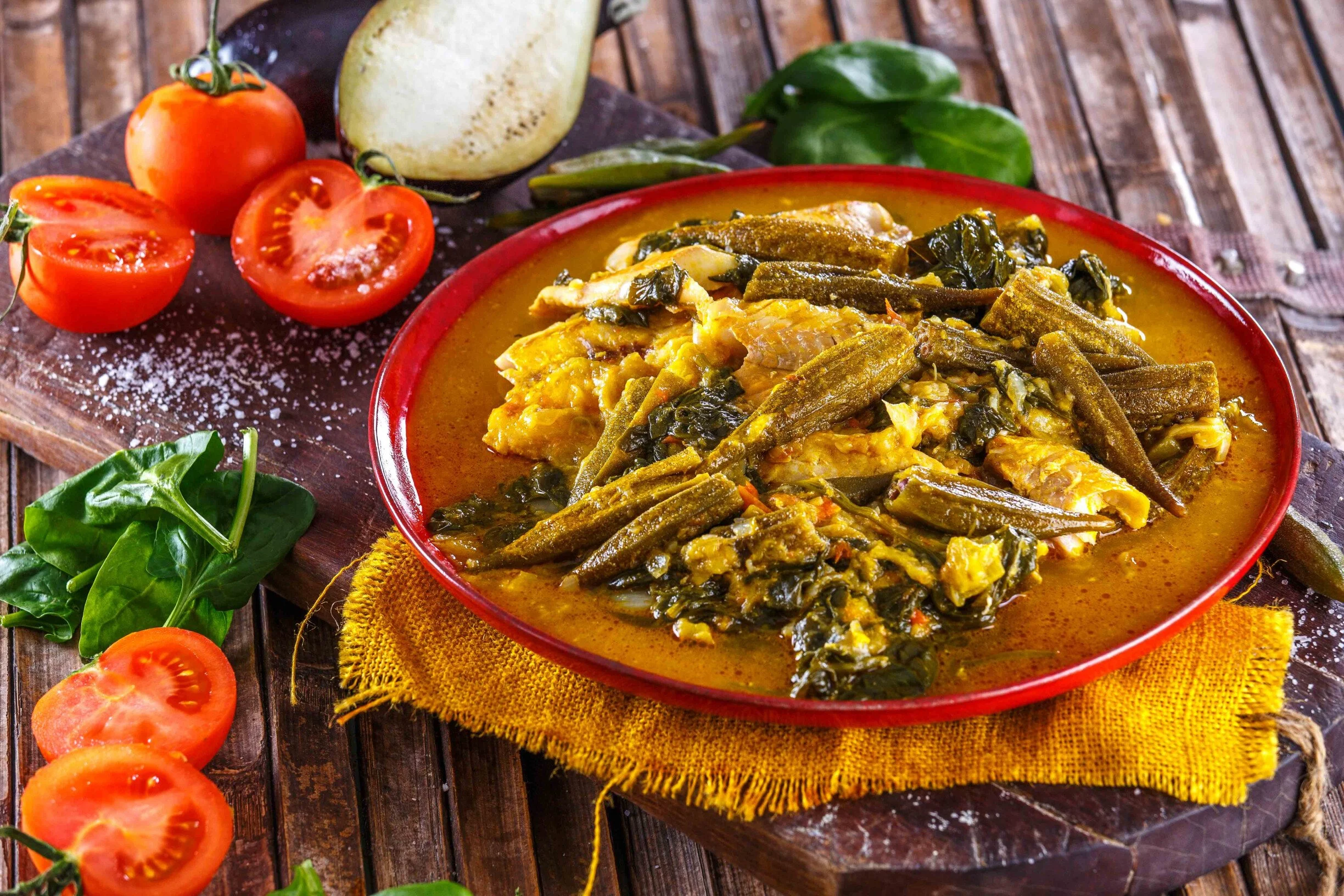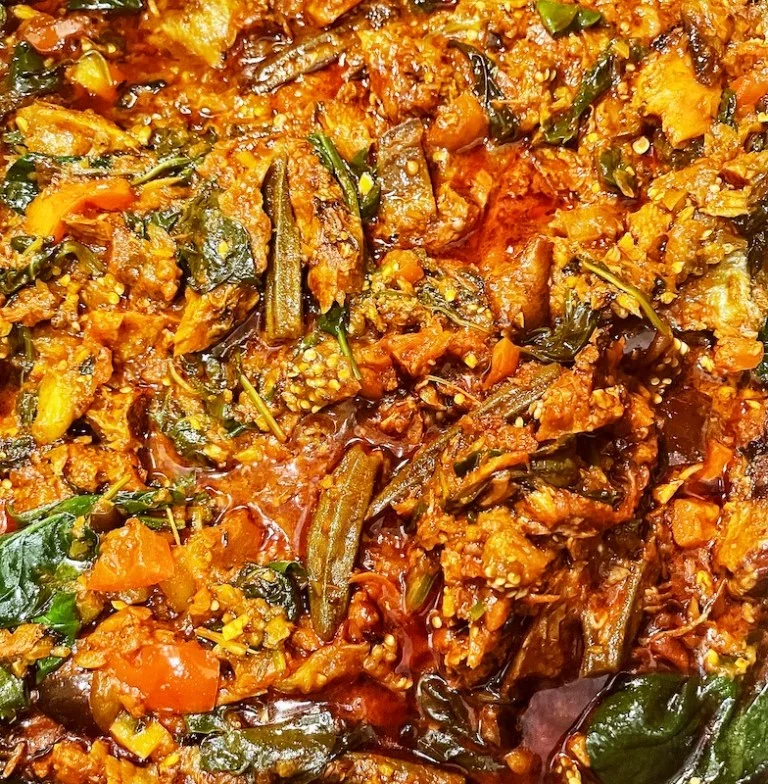Calulu de Peixe: The Stew That Defines Angolan Home Cooking
By: Chimdindu Ken-Anaukwu
Every Angolan home has its own rhythm: the hum of conversation, the scent of palm oil, and, somewhere in the kitchen, the gentle simmer of Calulu de Peixe.
This isn’t just another stew. Calulu is the edible heartbeat of Angola, a dish that tells stories of trade, colonization, resilience, and creativity. It’s where Portuguese techniques meet African ingredients, forming a blend so perfect that every spoonful feels like memory and heritage in one bite.
In Angola, food isn’t just nourishment. It’s continuity, the way families remind themselves who they are.
What Exactly Is Calulu de Peixe?
At its core, Calulu de Peixe is a fish stew made with dried or fresh fish, okra, eggplant, onions, tomatoes, and the golden foundation of African cooking: palm oil (azeite de dendê).
It’s slow-cooked to perfection, usually served with funje, a smooth cassava porridge that soaks up the rich sauce.
But what makes Calulu special is its complex simplicity; no two homes make it exactly the same.
Some add pumpkin leaves (folhas de abóbora), others slip in smoked fish for depth. Each version is a signature of love.
A Fusion Born from History
To understand Calulu de Peixe, you have to look back.
When the Portuguese arrived on Angolan shores, they brought with them their stews and cooking techniques. But local cooks, ingenious and resourceful, reclaimed and redefined these methods with African ingredients.
What emerged was Calulu: a stew that carried both worlds. The Portuguese love for layering flavors met the African instinct for grounding meals in nature: in leaves, oils, and sun-dried fish.
In a way, Calulu became the culinary symbol of Angola’s dual heritage: colonial influence turned into cultural power.
How It’s Made (The Traditional Way)
There’s no rush when cooking Calulu de Peixe.
The secret is in patience and respect for the ingredients.
Here’s the traditional process:
Soak the dried fish overnight to remove excess salt.
Slice the vegetables thinly: okra, onions, tomatoes, and eggplants.
Layer the pot: start with palm oil, then add onions, fish, tomatoes, and greens.
Simmer slowly, letting everything meld into a thick, aromatic sauce.
Serve with funje or rice, preferably with people you love nearby.
When that first spoonful hits your tongue, the taste is unmistakable; smoky, earthy, and deeply comforting.
More Than a Meal: A Memory of Home
For Angolans in the diaspora, Calulu de Peixe is often the first dish they crave.
It smells like homecoming.
The aroma alone, palm oil and smoked fish, can bring someone to tears. It’s a reminder that no matter where you go, your roots travel with you.
Even among young Angolans today, cooking Calulu has become an act of pride, a way to say, “I may live abroad, but my flavor is Angolan.”
How to Say It (and Sound Local)
If you’re learning Portuguese, here’s how to say it right:
Calulu de Peixe → kah-loo-loo deh pay-shuh
In Angola, someone might ask:
“Já comeste Calulu hoje?” (Have you eaten Calulu today?)
And you can proudly reply:
“Sim, e estava uma delícia!” (Yes, and it was delicious!)
Food Vocabulary to Learn in Portuguese
| English | Portuguese | Example |
|---|---|---|
| Fish | Peixe | O peixe está fresco. |
| Palm oil | Azeite de dendê | O Calulu leva azeite de dendê. |
| Stew | Ensopado | Este ensopado é típico de Angola. |
| Okra | Quiabo | O quiabo dá textura ao Calulu. |
| Tasty | Saboroso | O Calulu de Peixe é muito saboroso. |
The NKENNE Takeaway
If you ever find yourself in Angola or near an Angolan kitchen, never say no to Calulu de Peixe.
It’s not just food.
It’s Angola’s way of saying: Welcome. Sit. Eat. You belong here.
And if you’re learning Portuguese with NKENNE, remember: every meal has a language.
Start with Calulu, and you’re already tasting Portuguese the African way.
FAQs
1. What does “Calulu de Peixe” mean in English?
It means “Fish Calulu”, a traditional Angolan fish stew.
2. Is Calulu always made with fish?
No, some versions use dried meat or a mix of both fish and meat, but Calulu de Peixe specifically highlights fish.
3. What’s the difference between Calulu and Moamba?
Moamba is palm oil–based and spicier, while Calulu focuses more on vegetables and dried fish.
4. Can vegetarians enjoy Calulu?
Yes! There are plant-based versions that use mushrooms or eggplant instead of fish.
5. Where can I try authentic Calulu de Peixe?
Look for Angolan restaurants in Luanda, Lisbon, or diaspora hubs like London, Paris, and Rio, or better yet, ask an Angolan friend to cook it for you.







